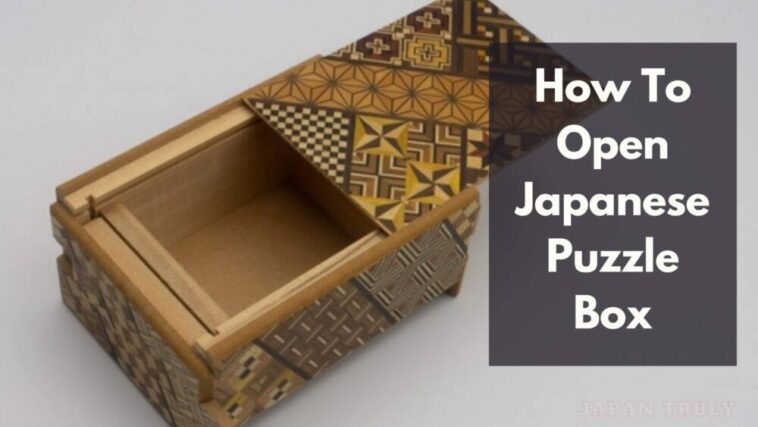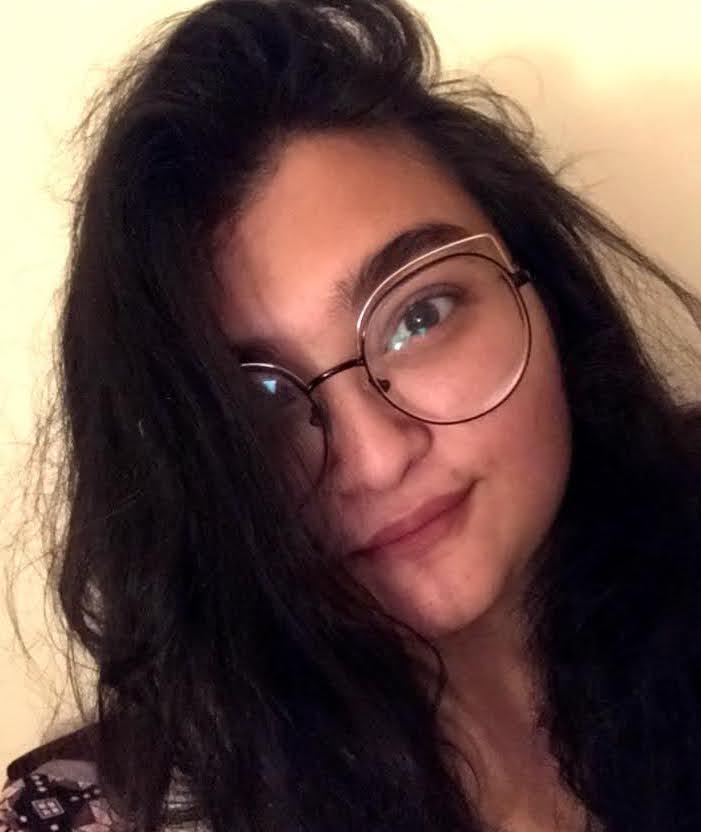Curious about the mysterious Japanese puzzle boxes? Here’s a guide to Japanee puzzle boxes. After reading this guide you should be able to open any Japanese puzzle box.
Intrigued by intricate wooden boxes with hidden secrets? Welcome to your guide to Japanese puzzle boxes!
Discover the history, types, and challenges of these beautiful handcrafted marvels. Get ready to test your skills and unlock the fascinating world of Japanese ingenuity.
Page Contents
Guide To Japanese Puzzle Boxes
Origin Of Japanese Puzzle Boxes
The origin of Japanese puzzle boxes can be dated back to the late 19th century in the Hakone region of Japan. Even today some of the most authentic Japanese puzzle boxes are made on the outskirts of Hakone.

The Japanese term for puzzle boxes is himitsu-bako which translates to a personal secret box.
They are also occasionally referred to as ‘tie bako’ or ‘sikake bako’ which interprets the trickery and wisdom of the creators of Japanese puzzle boxes.

The development of puzzle boxes in Japan became widespread during the Edo period when carriage bearers began selling marquetry items and puzzle boxes to people across the neighborhoods.
The major function of these Japanese puzzle boxes was to ensure that traveling workers would be able to conceal any valuable possessions including money and jewelry from thieves and highwaymen.
The puzzle boxes in Japan were orchestrated in a manner that only the owner of the puzzle box would be aware of the movements to disclose any content that’s stored within thus effectively preventing theft.
In addition, the Japanese puzzle boxes were also crafted to look like ornaments hence robbers would have that impression when coming across them.
At the dawn of the 21st century, it almost seemed as if the art of crafting puzzle boxes was dying. However, due to puzzle box collectors and avid craftsmen, a variety of mindblowing puzzle box designs with unprecedented content have emerged in the market.
Presently, puzzle boxes inspired by Japanese layouts are manufactured in a number of countries such as Turkey, Poland, Vietnam, Costa Rica, and most certainly Japan as well.
How Do Japanese Puzzle Boxes Work?
Every Japanese puzzle box is crafted in a distinctive composition and no one Japanese puzzle box is the same. Most popular Japanese puzzle boxes are either rectangular or square-shaped.

However, thanks to competent puzzle artisans, we have a large miscellany of Japanese puzzle boxes that are available in any shape or size you can ever imagine.
Some of the unorthodox Japanese puzzle boxes that have been a recent trend are houses, fruits, hearts, pyramids, and stars.
There are even Japanese puzzle boxes that are comprised of money slots where you can store cash.
Speaking of puzzle boxes with money slots, did you know that there are Japanese puzzle boxes in which you have to insert a specific number of coins to open them?
Regardless of the structure of the Japanese puzzle boxes, they are generally quite tough to solve.
Hence, puzzle boxes nowadays are crafted in accordance with difficulty ratings from beginner to intermediate and advanced.
If you were to acquire a Japanese puzzle box that can only be unlocked with a series of complex moves, the puzzle craftsmen will simply offer you the puzzle box catalog which lists down the maneuvers to decode it.
What makes Japanese puzzle boxes captivating are their physical characteristics, movements, and tricks.
In order to decipher a puzzle box, you must perform a sequence of intricate movies like lifting, sliding, and unlocking.
While some Japanese puzzle boxes only require a few moves to unlock, a vast majority of these puzzle boxes can only be cracked after carrying out at least 20 steps of movement.
In certain instances, after deciphering every motion of a Japanese puzzle box, you might be left with a key to unlock the ultimate secret compartment of the puzzle box or to reveal the final reward. The reward or trophy hidden within the puzzle box can vary.
Most often Japanese puzzle boxes with secret compartments containing prizes like charms or a minuscule gift.
The Layout Of Japanese Puzzle Boxes
The layout and the exterior of the Japanese puzzle boxes are the significant features that make them look extraordinary.
The traditional Japanese puzzle boxes differ greatly from the puzzle boxes present nowadays.
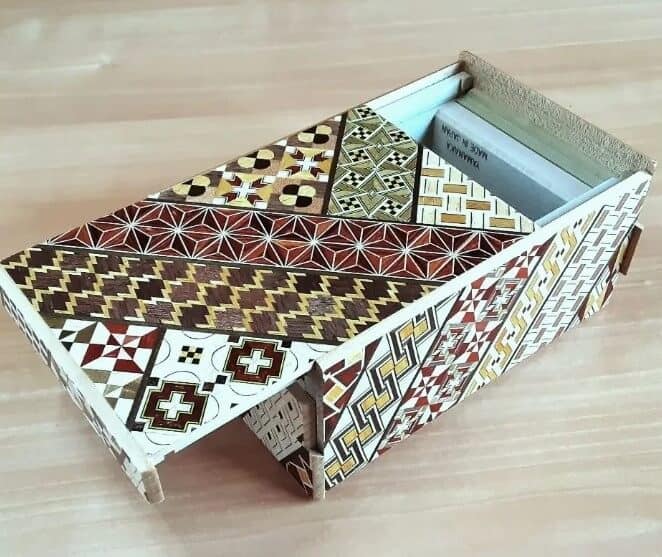
During the late 19th century, Japanese puzzle boxes were crafted using natural wood that was collected from an assortment of trees found in the Hakone region.
The contrasting collection of woods used to craft these puzzle boxes provided them with distinct shades and textures. The iconic design ancient Japanese puzzle boxes are adorned with is a geometric pattern called ‘yosegi-zaiku’ which is a wooden mosaic.
The yosegi-zaiku is one of the most convoluted puzzle box adornments to craft as it requires distinct types of wooden rods to be layered and sliced into thin yet sturdy sheets of wood.
When the procedure of yosegi-zaiku pattern is formed, the general embellishments designed on the puzzle boxes are Mount Fuji, and popular sceneries in the Hakone region like lakes, waterfalls, and mountains.
Once the puzzle boxes are orchestrated and the final adornments are implemented, the surface of the Japanese puzzle boxes is coated with lacquer to add a glossy finish to the puzzle boxes.
How To Open A Japanese Puzzle Box?
As a newbie to Japanese puzzles, it’s quite the norm to struggle when attempting to solve them even if it is a beginner-tier Japanese puzzle box.
However, once you get the hang of solving two or more Japanese puzzle boxes, you’ll grasp how the tricks and techniques work.
Nevertheless, you ought to understand that every Japanese puzzle box is distinguished on its own thus the maneuvers are bound to vary.
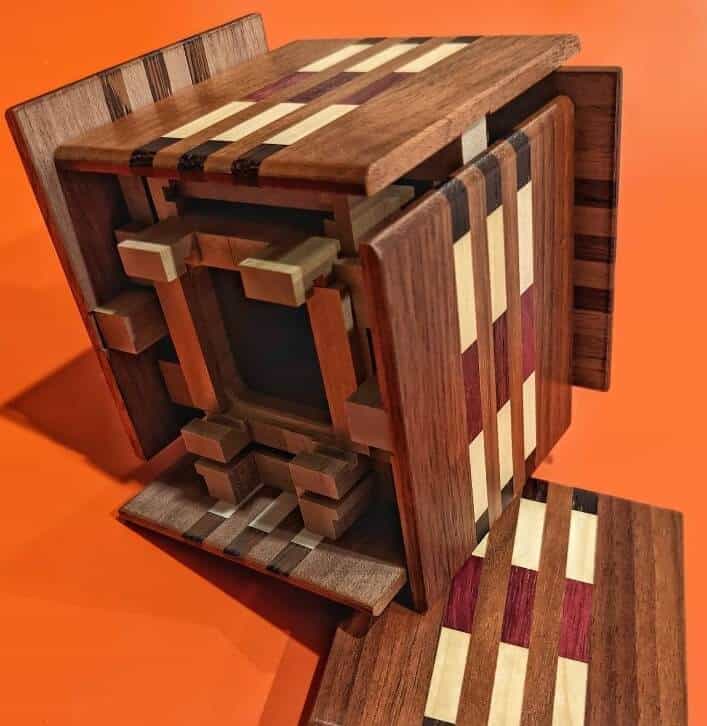
The number of steps for unraveling a Japanese puzzle box can range from 5 to 70 moves and the most recorded number of steps for solving a Japanese puzzle box is 1536.
Every step attempted to solve a Japanese puzzle box must be cautiously followed since these puzzle boxes are mechanized to perform in a certain sequential order.
The steps are comprised of both linear and nonlinear moves and right after you have figured out the first step, the second step can be tough to decipher. Gradually, every step to unraveling the Japanese puzzle box can get complicated.
The number of moves as well as the trickery behind them will also depend on the difficulty rating of the Japanese puzzle box.
In order to maintain a usable Japanese puzzle box it is best to ensure that you store it in a warm place free from humidity and open air. This is because Japanese puzzle boxes are manufactured out of natural wood hence they are susceptible to breeding mold.
Furthermore, placing a Japanese puzzle box in an ill-suited environment will ruin the appearance and functionality of the puzzle box thus making your puzzling experience unexciting.
Not to mention how extravagant these things are and coming across an original Japanese puzzle box is not easy.
Japanese puzzle boxes aren’t solely constructed for amusement activities but also to store any tchotchke or precious ornaments you own and they are hands down a lovely souvenir as well.
Constructing A Japanese Puzzle Box
Crafting a Japanese puzzle box is by no means an effortless task unless you are already an experienced puzzle artisan.
Similar to how unlocking a puzzle requires a number of motions and tactics, the development of Japanese puzzle boxes calls for several materials like authentic wood, glue, gear, and above all the time and competence to perfectly build a well-performing puzzle box.
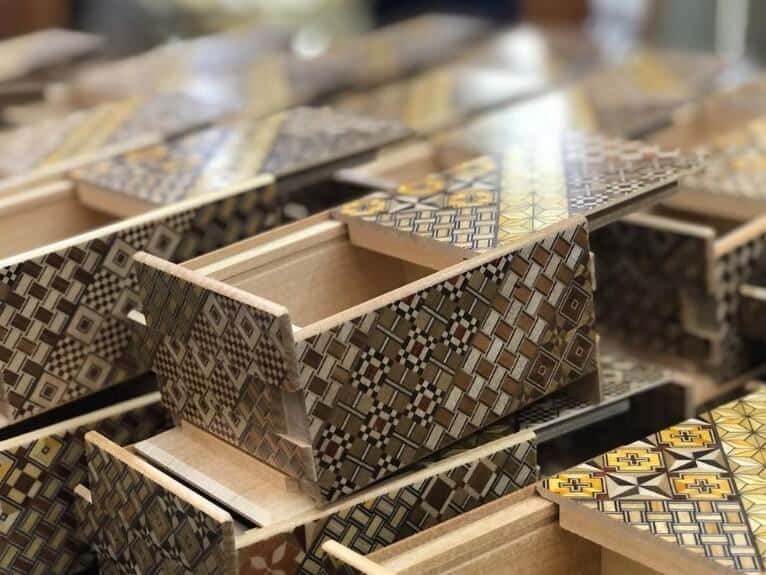
Since puzzle boxes are specifically developed to twist, turn, slide, and perform all sorts of movements, every material that is essential to put together a Japanese puzzle box must be carefully placed and fixed in order to allow swift maneuvering.
Every step of the puzzle-crafting procedure must be done with caution as it should ultimately create a puzzle box that can be solved.
The procedure of formulating a Japanese puzzle box can get even tougher and more intricate when the size of the puzzle box becomes larger as this would also involve an increment in the number of steps to solve the puzzle box as well.
Any Japanese puzzle box that is either extremely tight or too loose to twist and turn will just be a buzzkill for the person attempting to decode the puzzle.
Himitsu Bako puzzle makers in Japan craft every nook and cranny of the Japanese puzzle box. The wood used to craft these puzzle boxes are heavily inspected and then left to dry to ensure they’re convenient to work with.
The next step would involve cutting and assembling the sheets of wood to create a puzzle box.
When each wood sheet is placed, the puzzle artisans examine how they could be moved which ensures that nobody can attempt to cheat to solve the puzzle.
Since the entire scheme of creating a traditional Japanese puzzle box is complex, there are not many Japanese puzzle craftsmen out there leading to an insignificant number of suppliers which contributes to the exorbitant rates of these treasures.
Also Read
My writing focuses on the various aspects of Japanese lifestyle, from traditional tea ceremonies and flower arrangement to modern fashion trends and pop culture. Through my articles, I aim to share my passion for Japan and provide readers with a glimpse into the rich and diverse world of Japanese culture.
I believe that the key to understanding Japanese lifestyle is to appreciate the balance between tradition and innovation. While Japan has a rich cultural heritage that dates back centuries, it is also a country that is constantly evolving and embracing new ideas and technologies.
Whether you’re interested in learning about the latest fashion trends in Tokyo, or want to explore the ancient art of calligraphy, my writing will take you on a journey through the many facets of Japanese lifestyle. So join me as we explore the beauty and complexity of this fascinating culture together!


